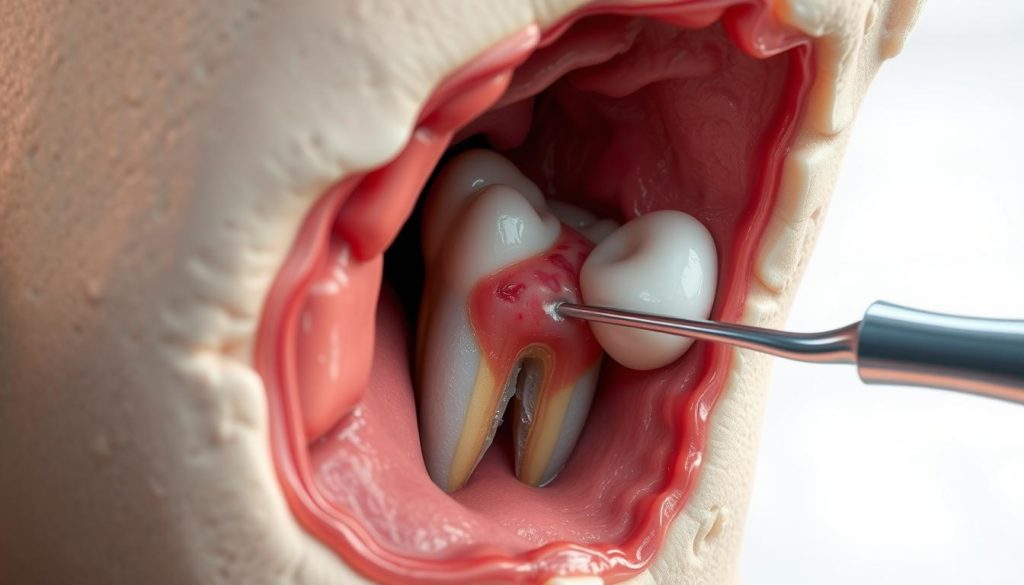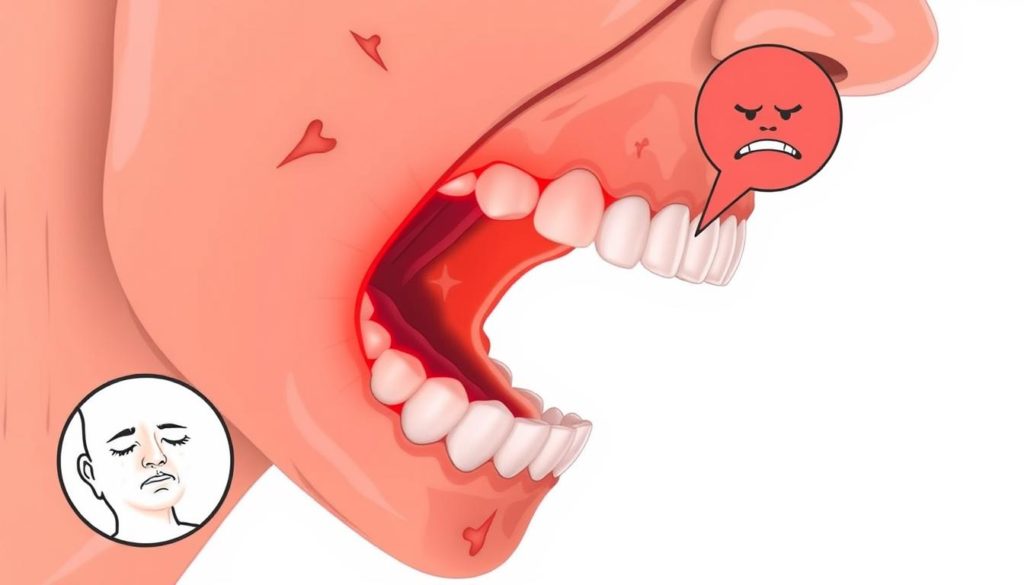Did you know that nearly 2% to 5% of patients who get a tooth pulled develop dry socket? This might seem like a small percentage, but for those who get it, the pain is intense. Taking good care of your mouth after surgery is key to avoiding this.
Dry socket, or alveolar osteitis, can really slow down your healing. It can make you feel more pain for longer. Knowing how to prevent dry socket and manage pain is crucial for a quick recovery.
This article will give you important tips. It will help you understand dry socket better. Being informed can help you avoid risks and heal faster and more comfortably.
What is Dry Socket?
Dry Socket, also known as alveolar osteitis, is a common issue after a tooth extraction. It happens when the blood clot in the socket, the hole left by the tooth, either dissolves or gets dislodged. This exposes the bone and nerves, causing severe pain.

Definition and Symptoms
The main symptoms of Dry Socket include severe pain that starts a few days after the extraction. This pain can spread to the ear, eye, or neck on the same side of the face. You might also notice a foul odor from your mouth due to the exposed bone and tissue.
Other signs include bad breath and an unpleasant taste in your mouth.
Common Causes
Several factors can lead to alveolar osteitis. Not following your dentist’s post-operative care instructions is a big cause. Smoking also hinders blood clot formation and healing.
Sometimes, tooth extraction complications during the procedure can cause Dry Socket. This includes too much trauma to the site or using the wrong techniques during extraction.
| Common Symptoms | Common Causes |
|---|---|
| Severe Pain | Improper Post-Operative Care |
| Bad Odor | Smoking |
| Foul Taste | Tooth Extraction Complications |
Signs and Symptoms of Dry Socket
After a tooth extraction, watch for signs of Dry Socket. Spotting early signs is key to managing it well. Knowing what to look for helps you tell Dry Socket from normal pain.

Pain and Discomfort
Severe pain is a main symptom of Dry Socket, starting a few days after the extraction. This pain is intense and can spread to the ear, eye, temple, or neck. Over-the-counter pain meds usually don’t help much.
Visible Bone in the Socket
Another sign is seeing bone in the extraction site. If the socket looks empty, with no blood clot, it’s a sign of Dry Socket. You might also notice a bad taste or smell, which means infection is likely.
| Common Symptoms | Dry Socket | Normal Post-Extraction |
|---|---|---|
| Pain Intensity | Severe and radiating | Mild to moderate |
| Visible Bone | Present | Absent |
| Odor or Taste | Unpleasant | Neutral |
Why Dry Socket Occurs After Tooth Extraction
Understanding why dry socket happens after a tooth extraction is key. Knowing about blood clots and bacterial infections helps. This way, patients can take better care of their teeth.
Role of Blood Clot
A blood clot forms after a tooth is pulled. It protects the bone and nerves. If it gets knocked out, it can cause dry socket and slow healing.
Keeping the clot in place is crucial. It helps prevent dry socket and speeds up recovery.
Impact of Bacterial Infection
Bacteria can make dry socket worse. They can break down the blood clot and slow healing. Keeping your mouth clean is important.
Use antibacterial rinses as directed. This helps prevent infections and speeds up healing.
Prevention Tips for Dry Socket
Getting a dry socket can be very painful. But, there are ways to lower the risk and make recovery easier. By following the best advice and aftercare tips, you can greatly reduce the chance of getting a dry socket.
- Avoid Smoking: Smoking can slow down healing and increase dry socket risk. Try to stop smoking at least a day before and a week after surgery.
- Follow a Soft Diet: Eat soft or liquid foods to avoid irritating the surgery area. Yogurt, soups, and mashed potatoes are good choices.
- Arranging Rest Time: Rest well after your dental procedure. Too much activity can slow healing and raise dry socket risk.
Drinking lots of water is key in dental care best practices. It keeps tissues moist and helps healing. Also, clean your mouth carefully without touching the surgery area. Use saline solutions for rinsing and avoid straws to prevent dislodging blood clots.
| Medication | Purpose |
|---|---|
| Antibiotics | Prescribed to prevent or treat any potential bacterial infections that could lead to dry socket. |
| Pain Relievers | Helps manage any discomfort during the recovery, allowing better rest and healing. |
Knowing about oral surgery aftercare tips and following them closely is crucial. It helps reduce the risk of Dry Socket. Talk to your dentist for personalized advice and always follow their guidance for the best recovery.
Care Tips After Tooth Extraction
Proper dental care is key for a smooth recovery and to avoid issues like dry socket. Knowing the best care steps and following do’s and don’ts can help a lot. Here are some important tips to follow after your tooth is extracted.
Immediate Post-Operative Care
- Keep the Gauze Pad in Place: After the extraction, keep the gauze pad on the extraction site for at least 30 to 45 minutes. This helps a blood clot form and reduces bleeding.
- Apply Ice Packs: Use ice packs on the cheek near the extraction site to reduce swelling. Apply for 15 minutes on and 15 minutes off during the first 24 hours.
- Take Prescribed Medications: Follow your dentist’s instructions for pain relievers and antibiotics. This helps prevent infection and manage pain.
- Rest and Elevate: Avoid physical exertion and keep your head elevated while resting. This helps minimize swelling and bleeding.
Do’s and Don’ts
- Do eat soft foods like yogurt, soup, and mashed potatoes during the healing period. Gradually add solid foods as the site heals.
- Do maintain proper oral hygiene by gently brushing your teeth and rinsing with a saline solution after the initial 24 hours.
- Do stay hydrated by drinking plenty of water.
- Don’t smoke or use tobacco products for at least 48 hours post-surgery. They can impede healing and increase the risk of dry socket.
- Don’t use drinking straws, spit forcefully, or rinse vigorously for the first 24 hours. These actions can dislodge the blood clot.
- Don’t eat hard, crunchy, or spicy foods that might irritate the extraction site.
Following these post-operative best practices can greatly help in healing after oral surgery. It reduces the risk of complications and makes the recovery process more comfortable. Always remember to follow your dentist’s personalized advice along with these general guidelines.
Home Remedies to Alleviate Dry Socket Pain
Dealing with Dry Socket can be really uncomfortable. But, there are many home remedies that can help. These are suggested by dental healthcare providers to ease the pain.
Rinses and Compresses
Using rinses and compresses is a great way to treat Dry Socket. Warm saltwater rinses can clean the area. Just mix 1/2 teaspoon of salt in a cup of warm water and rinse gently.
This can cut down on bacteria and ease the pain. Cold and warm compresses also help. Use cold compresses for the first 24 hours, then switch to warm ones. This can reduce swelling and help with pain relief.
Over-the-Counter Pain Relievers
For dental pain from Dry Socket, over-the-counter pain relievers work well. Ibuprofen or acetaminophen can help with pain and swelling. Always take the right amount as directed by the maker or your dentist.
Some people find medicated oral gels helpful. These gels can numb the pain for a while. They offer relief as part of your treatment for alveolar osteitis.
Professional Treatment Options
If you’re dealing with dry socket, there are many professional treatments available. Expert dental care can help manage pain and speed up healing.
Prescription Medications
Dentists often give out special meds for dry socket. These include painkillers and antibiotics to fight off infections. These medicines are key in pain management solutions, helping to ease pain quickly.
Dental Procedures
There are also dental procedures that can help a lot. Dentists might clean the area and put on medicated dressings. These steps are done by dental experts to treat dry socket effectively.
Getting professional help is very important for dry socket. With the right meds and dental procedures, you can get relief from pain and help your body heal.
How to Speed Up the Healing Process
To heal Dry Socket quickly, eat well and keep your mouth clean. Choose foods that help your gums and teeth. Also, follow good oral hygiene habits to speed up healing.
Healthy Diet Considerations
Eating right is key for gum health and quick healing. Foods full of vitamins and minerals help fix gum damage and cut down swelling:
- Vitamin C-rich foods: Oranges, strawberries, and bell peppers
- Foods high in calcium: Milk, cheese, and yogurt
- Leafy greens: Spinach and kale
- Omega-3 fatty acids: Salmon and flaxseeds
Drink plenty of water and avoid hard, crunchy, or acidic foods. This helps prevent more irritation and aids in healing Dry Socket.
| Nutrient | Foods to Eat | Benefits |
|---|---|---|
| Vitamin C | Oranges, strawberries | Boosts collagen production for gum repair |
| Calcium | Milk, cheese | Strengthens bone and tooth structure |
| Omega-3 | Salmon, flaxseeds | Reduces inflammation |
Good Oral Hygiene Practices
Good oral care is crucial for healing Dry Socket and keeping your mouth healthy. Here are some important steps:
- Gentle Brushing: Use a soft-bristled toothbrush to gently clean around the extraction site, avoiding direct contact with the wound.
- Rinsing: Rinse your mouth with a saline solution or an antiseptic mouthwash to reduce bacterial load and prevent infection.
- Avoid Smoking: Refrain from smoking, as it can impede the healing process and introduce harmful toxins.
- Regular Check-ups: Schedule follow-up visits with your dentist to monitor the healing progress and address any complications promptly.
Following these diet and hygiene tips can make your recovery smoother and improve your mouth’s health.
Role of Dentists in Managing Dry Socket
Managing dry socket is more than just home care. Visiting your dentist is key to healing. They check your teeth regularly to catch any problems early. Dentists can also help reduce pain and speed up healing.
Follow-up dental visits are crucial. They let dentists keep an eye on how you’re healing. They might use special dressings or give you medicine to help. Sometimes, they might need to do more to help you heal right.
Regular dental visits are vital after a tooth extraction. Dentists help keep your mouth healthy and prevent future issues. They make sure your teeth heal properly. This is why dentists are so important in treating dry socket.
FAQ
What is Dry Socket?
Dry Socket, also known as alveolar osteitis, is a painful dental condition. It can happen after a tooth extraction. This occurs when the blood clot at the extraction site either dissolves or becomes dislodged before the wound heals.
What are the symptoms of Dry Socket?
Symptoms include severe pain that can spread to your ear, eye, temple, or neck. You might also notice an empty-looking socket, bad breath, and an unpleasant taste in your mouth.
What causes Dry Socket?
Causes include improper post-operative care, smoking, using a straw, or trauma at the extraction site. These factors can prevent the blood clot from forming or lead to its loss, which is essential for healing.
How can you identify Dry Socket?
To identify Dry Socket, look for intense pain after extraction that doesn’t get better with painkillers. You might also see visible bone where your tooth was removed.
Why does Dry Socket occur after tooth extraction?
Dry Socket happens when the blood clot at the extraction site either dissolves or becomes dislodged. Bacterial infection can also play a role, preventing the clot from forming properly.
What prevention tips can reduce the risk of Dry Socket?
To prevent Dry Socket, avoid smoking, using straws, and hard foods after surgery. Follow your dentist’s advice on oral care and medication carefully.
What are some care tips after tooth extraction?
Immediate care includes gently biting down on gauze to help form a clot. Avoid vigorous rinsing or spitting. Take prescribed painkillers and antibiotics as instructed by your dentist.
Are there any home remedies to alleviate Dry Socket pain?
Yes, you can manage pain with saline or medicated rinses, cold or warm compresses, and over-the-counter pain relievers like ibuprofen or acetaminophen.
What professional treatment options are available for Dry Socket?
Treatment options include prescription medications like analgesics and antibiotics. Dental procedures like packing the socket with medicated dressings can also relieve pain and promote healing.
How can you speed up the healing process?
Eating a nutritious diet high in vitamins and minerals helps. Practicing good oral hygiene like gentle brushing and using antibacterial mouthwash also speeds up healing.
What role do dentists play in managing Dry Socket?
Dentists are crucial in diagnosing, treating, and preventing Dry Socket. They conduct regular assessments, provide professional care, and ensure the socket heals correctly, minimizing complications.


